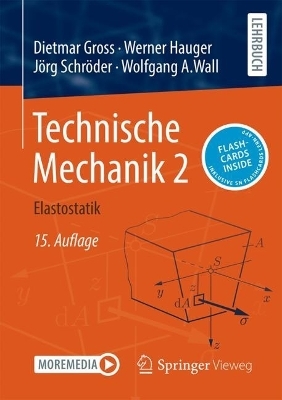
Newtonian Dynamics
CRC Press (Verlag)
978-1-032-05666-1 (ISBN)
Each chapter of the book ends with a large number of numerical and analytical exercises and, in all appropriate cases, the final answers to the exercises are specified. The large number of exercises will allow students to accurately test their understanding of the material presented in the book, ideal for students who are self-studying or are taking classes remotely.
Key Features:
Provides a brief and accessible introduction to a complex topic
Contains a more thorough treatment of the motions of heavenly bodies than conventional elementary mechanics texts
Provides a wealth of end-of-chapter exercises to test understanding
Richard Fitzpatrick is a Professor of physics at the University of Texas at Austin, USA, where he has been a faculty member since 1994. He is a member of the Royal Astronomical Society, a fellow of the American Physical Society, and the author of several textbooks.
Richard Fitzpatrick is a Professor of physics at the University of Texas at Austin, USA, where he has been a faculty member since 1994. He is a member of the Royal Astronomical Society, a fellow of the American Physical Society, and the author of several textbooks.
Preface
Acknowledgements
Measurement and Units
Mks Units
Standard Prefixes
Other Units.
Dimensional Analysis
Experimental Errors
Exercises
Motion in One Dimension
Introduction
Displacement
Velocity
Acceleration
Motion with Constant Velocity
Motion with Constant Acceleration
Useful Results
Free-Fall Under Gravity
Exercises
Motion in Three Dimensions
Introduction
Vector Mathematics
Scalars and Vectors
Vector Algebra
Cartesian Components of a Vector
Coordinate Transformations
Scalar Product
Vector Product
Vector Displacement, Velocity, and Acceleration
Motion with Constant Velocity
Motion with Constant Acceleration
Projectile Motion
Relative Velocity
Exercises
Newton's Laws of Motion
Introduction
Newton's First Law of Motion
Newton's Second Law of Motion
Measurement of Force
Newton's Third Law of Motion
Mass, Weight, and Reaction
Block Resting on Earth's Surface
Block in an Elevator
Suspended Masses
Block Suspended by a Single Cable
Block Suspended by Three Cables
Two Blocks Suspended by Five Cables
Many Blocks Suspended by Many Cables
Catenary
Suspension Bridge
Cable-Pulley Systems
Simple Pulley
Compound Pulley
Table Pulley
Atwood Machine
Velocity-Dependent Forces
Friction
Inclined Planes
Smooth Planes
Rough Planes
Frames of Reference
Exercises
Conservation of Energy
Introduction
Energy Conservation During Free-Fall
Work
Conservative and Non-Conservative Force-Fields
Potential Energy
Hooke's Law
Motion in a General One-Dimensional Potential
Power
Exercises
Conservation of Momentum
Introduction
Two-Component Systems
Hot-Air Balloon
Cannon and Cannonball
Multi-Component Systems
Explosion of Krypton
Rocket Science
Impulses
Bouncing Ball
One-Dimensional Collisions
Elastic Collisions
Totally Inelastic Collisions
Inelastic Collisions
Two-Dimensional Collisions
Exercises
Circular Motion
Introduction
Uniform Circular Motion
Centripetal Acceleration
Rotating Weight on the End of a Cable
Banked Curve
Conical Pendulum
Non-Uniform Circular Motion
Vertical Pendulum
Motion on Curved Surfaces
Fairground Ride
Skier on a Hemispherical Mountain
Exercises
Rotational Motion
Introduction
Rigid Body Rotation
Is Rotation a Vector?
Center of Mass
Centroid of Regular Pyramid
Moment of Inertia
Perpendicular Axis Theorem
Parallel Axis Theorem
Moment of Inertia of a Circular Disk
Standard Moments of Inertia
Torque
Power and Work
Translational Motion Versus Rotational Motion
Unwinding Pulley
Physics of Baseball Bats
Combined Translational and Rotational Motion
Cylinder Rolling Down a Rough Incline
Exercises
Angular Momentum
Introduction
Angular Momentum of a Point Particle
Angular Momentum of an Extended Object
Angular Momentum of a Multi-Component System
Conservation of Angular Momentum
Two Movable Weights on a Rotating Rod
Figure Skater
Bullet Striking a Pivoted Rod
Spinning Top
Exercises
Statics
Introduction
Principles of Statics
Equilibrium of a Laminar Object
Rods and Cables
Horizontal Rod Suspended from Two Cables
Pivoting Horizontal Rod Supported by a Cable
Ladders and Walls
Jointed Rods
Tipping or Sliding?
Exercises
Oscillatory Motion
Introduction
Simple Harmonic Motion
Torsion Pendulum
Simple Pendulum
Compound Pendulum
Exercises
Rotating Reference Frames
Introduction
Rotating Reference Frames
Centrifugal Acceleration
Coriolis Force
Foucault Pendulum
Exercises
Newtonian Gravity
Introduction
Universal Gravity
Surface Gravity
Gravitational Potential Energy
Escape Velocity
Circular Orbits
Lunar Orbital Period
Geostationary Satellites
Exercises
Orbital Motion
Introduction
Kepler's Laws
Planetary Equations of Motion
Conic Sections
Kepler's Second Law
Kepler's First Law
Kepler's Third Law
Orbital Parameters
Orbital Energies
Transfer Orbits
Low-Eccentricity Orbits
Two-Body Dynamics
Binary Star Systems
Exercises
Gravitational Potential Theory
Introduction
Gravitational Potential
Axially-Symmetric Mass Distributions
Gravitational Potential due to a Uniform Sphere
Gravitational Potential Outside a Uniform Spheroid
Rotational Flattening
Rotational Flattening of Earth
Tidal Elongation
Tidal Elongation of Earth due to Moon
Tidal Elongation of Earth due to Sun
Ocean Tides
Luni-Solar Precession
Exercises
Useful Mathematics
Calculus
Series Expansions
Trigonometric Identities
Hyperbolic Identities
Complex Identities
Vector Identities
Bibliography
Index
| Erscheinungsdatum | 06.12.2021 |
|---|---|
| Zusatzinfo | 6 Tables, black and white; 133 Line drawings, black and white; 133 Illustrations, black and white |
| Verlagsort | London |
| Sprache | englisch |
| Maße | 178 x 254 mm |
| Gewicht | 453 g |
| Themenwelt | Mathematik / Informatik ► Mathematik ► Angewandte Mathematik |
| Naturwissenschaften ► Biologie | |
| Naturwissenschaften ► Physik / Astronomie ► Mechanik | |
| Naturwissenschaften ► Physik / Astronomie ► Quantenphysik | |
| Naturwissenschaften ► Physik / Astronomie ► Relativitätstheorie | |
| ISBN-10 | 1-032-05666-5 / 1032056665 |
| ISBN-13 | 978-1-032-05666-1 / 9781032056661 |
| Zustand | Neuware |
| Informationen gemäß Produktsicherheitsverordnung (GPSR) | |
| Haben Sie eine Frage zum Produkt? |
aus dem Bereich


